遥控器在哪儿?心力衰竭远程监测研究的临床工作流程报告失败。
IF 8.2
2区 医学
Q1 CARDIAC & CARDIOVASCULAR SYSTEMS
引用次数: 0
摘要
背景:远程患者监测(RPM)临床试验报告了改善慢性心力衰竭(HF)患者预后的混合结果。可能影响RPM有效性的临床工作流程的影响经常被忽视。我们试图描述可能影响心衰非侵入性RPM研究结果的工作流程和响应方案。方法:我们回顾了1999-2024年间评估成人心衰非侵入性RPM干预的研究。我们收集了24个方面的工作流程,包括教育、生理和症状数据收集、传输和审查、临床升级方案和响应时间。我们试图进行荟萃分析,以确定工作流程组成部分与死亡和住院结果之间的关联。结果:我们确定了63项研究(57.1%随机对照,23.8%试点/可行性,19.1%其他),包括16,699名受试者。尽管有大量的研究和主题,工作流报告不足以执行我们对关键工作流组件的预期荟萃分析。RPM临床工作流程在配置上是多样化的,在组件描述上有很高的可变性,范围从总是报告到从未报告。根据大多数试验假设,监测装置和相关培训的具体情况得到了充分的报告。然而,临床数据响应的要素,如数据审查频率、临床升级标准和提供者响应时间,往往被低估或根本没有报告(分别为48%、24%和97%),阻碍了研究的复制和基于证据的实施。结论:在非侵入性RPM研究中,临床工作流程描述不佳,妨碍了系统评估、设备比较和复制。报告HF RPM工作流程的标准化方法对于评估有效性和指导循证临床实施至关重要。本文章由计算机程序翻译,如有差异,请以英文原文为准。

Where's the Remote? Failure to Report Clinical Workflows in Heart Failure Remote Monitoring Studies
Background
Remote patient monitoring (RPM) clinical trials have reported mixed results in improving outcomes for patients with chronic heart failure (HF). The impact of clinical workflows that could impact RPM effectiveness is often overlooked. We sought to characterize workflows and response protocols that could impact outcomes in studies of noninvasive RPM in HF.
Methods
We reviewed studies (1999–2024) assessing noninvasive RPM interventions for adults with HF. We collected 24 aspects of workflows describing education, physiologic and symptomatic data collection, transmission and review, clinical escalation protocols, and response time. We attempted to perform a meta-analysis to identify associations between workflow components and outcomes of death and hospitalization.
Results
We identified 63 studies (57.1% randomized controlled, 23.8% pilot/feasibility, 19.1% other) comprising 16,699 subjects. Despite a large number of studies and subjects, workflow reporting was insufficient to perform our intended meta-analysis regarding key workflow components. RPM clinical workflows were diverse in configuration, with high variability in component description ranging from always reported to never reported. Specifics of monitoring devices and related training were well reported as expected based on most trial hypotheses. However, elements of clinical data response such as frequency of data review, clinical escalation criteria, and provider response time were often underreported or not reported at all (48%, 24%, and 97%, respectively), hindering study replication and evidence-based implementation.
Conclusions
Clinical workflows are poorly described in noninvasive RPM studies, preventing systematic assessment, device comparison, and replication. A standardized approach to reporting HF RPM workflows is vital to evaluate effectiveness and guide evidence-based clinical implementation.
求助全文
通过发布文献求助,成功后即可免费获取论文全文。
去求助
来源期刊

Journal of Cardiac Failure
医学-心血管系统
CiteScore
7.80
自引率
8.30%
发文量
653
审稿时长
21 days
期刊介绍:
Journal of Cardiac Failure publishes original, peer-reviewed communications of scientific excellence and review articles on clinical research, basic human studies, animal studies, and bench research with potential clinical applications to heart failure - pathogenesis, etiology, epidemiology, pathophysiological mechanisms, assessment, prevention, and treatment.
 求助内容:
求助内容: 应助结果提醒方式:
应助结果提醒方式:


